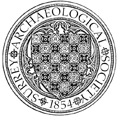Norfolk Archaeology
Submitted by Anonymous on

Submitted by Anonymous on
Submitted by Anonymous on
Poywsland Club
Submitted by Anonymous on
Submitted by Anonymous on
Submitted by Anonymous on
London and Middlesex Archaeological Society
Submitted by Anonymous on
Leicestershire Archaeological and Historical Society
Submitted by Anonymous on
Submitted by Anonymous on
Royal Society of Antiquaries of Ireland
Submitted by Anonymous on
Submitted by Anonymous on
Hampshire Field Club & Archaeological Society